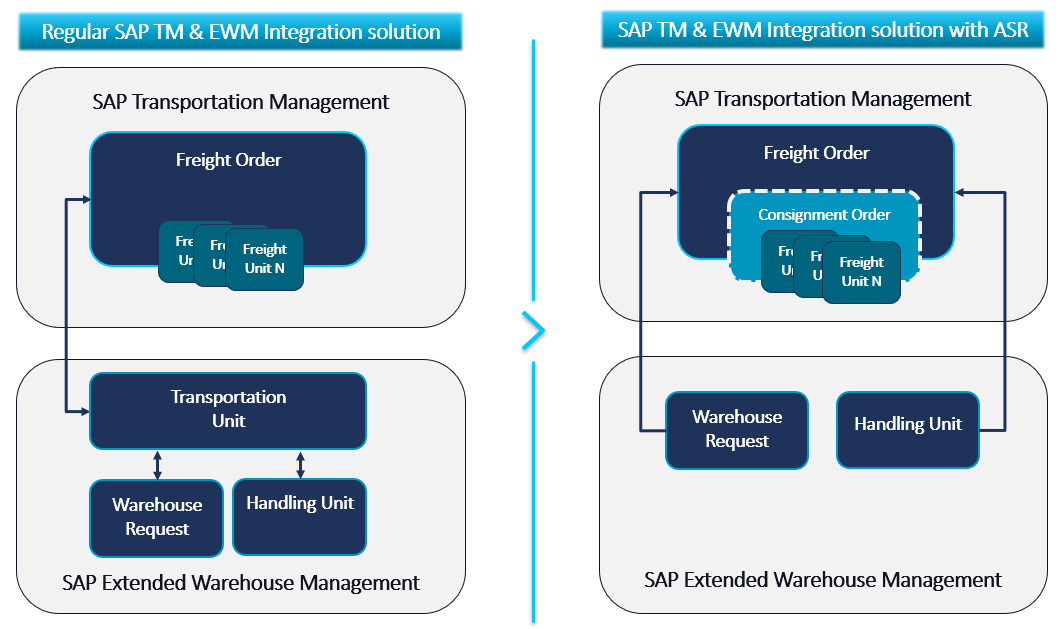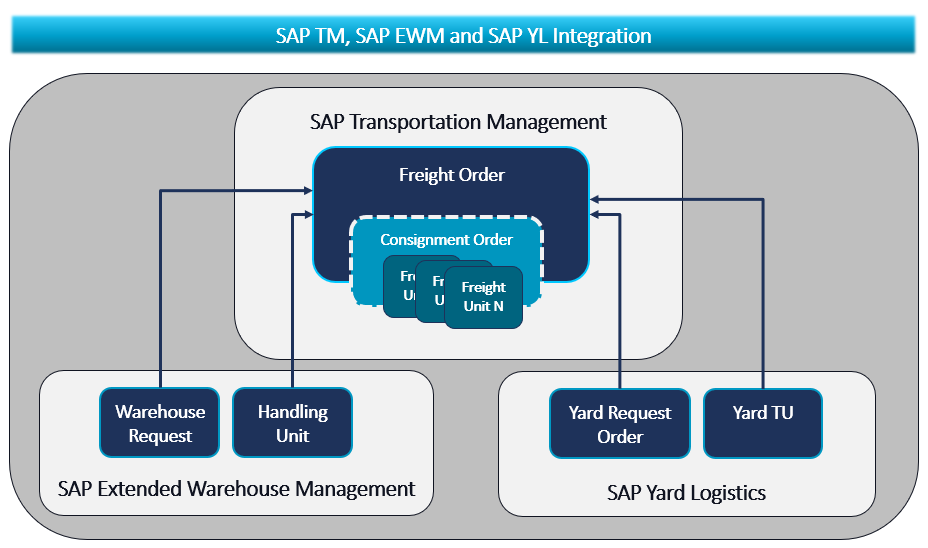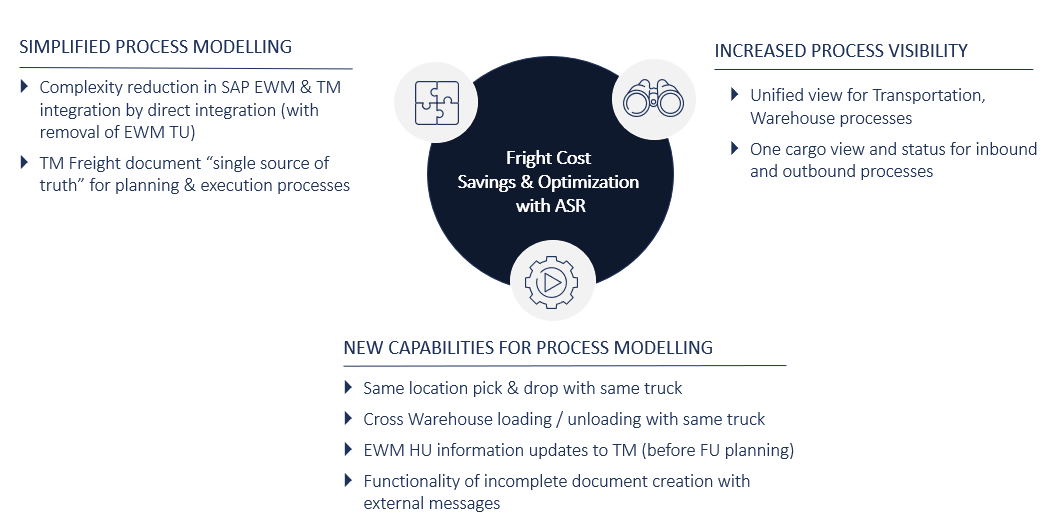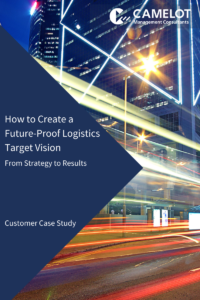In the recent past, multiple SAP Logistics execution transformation projects have observed challenges during implementations of transportation & warehouse applications, for example: communication issues between TM and WM applications, in-adequate process visibility for TM – WM business / IT users etc.
SAP has provided new strategic integration architecture for logistics execution applications with ‘Advance Shipping & Receiving’ (ASR) functionality, which reduces the technical complexity of the process and reduces ‘Total Cost of Ownership” of the system. With ASR, new scenarios modelling is possible with simplified integration. With this blog article let’s dive deep into ASR functionalities based on SAP S/4HANA 2022 release.
ASR Features & Integration Overview
Streamline EWM integration:
With ASR functionality, SAP TM’s freight document has become the central object for interaction and capturing of changes performed during transportation & warehouse processes. With ASR, direct integration from EWM to TM freight document is enabled. Hence “Transportation Unit” (TU)” of SAP EWM is not required for interactions between SAP EWM and TM.
Before ASR, the communication between TM and EWM applications (between freight order and transportation unit) were based on asynchronous LDAP messages, where communication issues have often been observed. With ASR, mentioned communication issues will be resolved, leading to improved process.

ASR enables modelling of new scenarios:
Some of the key scenarios which are enabled by ASR are mentioned below:
- Pick & drop at the same location with the same truck: with introduction of “loading / un-loading point” master data objects, it is now possible to model pickup / delivery doors where loading and unloading activities are performed. This enables scenarios modelling where same truck (freight order) can perform load pick & drop operations, at the same location.
- Cross warehouse loading / unloading with same truck: As loading – unloading doors can corresponds to different warehouses systems (IM / EWM managed), hence it enables scenarios modelling for cross warehouse loading / unloading using the same truck (freight order).
- Early update of packages (handling units) information to TM freight units (short: “FU”) before TM planning: In execution driven warehouse outbound scenario, packages (handling units) information from EWM can be updated to TM (freight units) before TM planning. This provides transport planner a better planning opportunity based on the real packages, leading to better utilization of vehicle resource space.
Improved Integration due to better error handling capabilities:
While processing the external messages, ASR provides enhanced error handling capabilities to have TM documents created even if all the information is not present as part of incoming messages. The errors are logged under “documents error” tab and the required corrections could be done manually. For example, EDI messages such as ASN, Bordero can be consumed from external business parties and generate TM transactional documents (consignment order, freight order).
Better integration with Yard Logistics
SAP Yard Logistics 2021 for SAP S/4HANA supports ASR feature, which enables better integration and deployment scenarios for SAP TM, SAP EWM and SAP YL modules. The pre-requisite to supports this new integration is that mentioned modules should be running in a single client.

Streamline communication between business parties by ASR with “consignment order (CO)”
In many transportation scenarios, the communication between business parties happens at consignment level. Introduction of SAP TM “Consignment Order” is a step closer to real business processes modelling in the system. Consignment order represents the group of products to be delivered by a business party (example supplier), to a certain destination on a specific delivery date. Consignment order can be directly created in SAP S/4HANA TM system or can be created by consuming ASN message from supplier (EDI inbound message).
ASR process with Consignment Order (CO) provides seamless exchange of consignment information, between supplier and manufacturer based on ASN messages. Also, consignment order enables supplier, manufacturer & forwarder to have same view of products being delivered, due to consignment-based communication.
Summary of ASR Benefits
With ASR functionality, modelling of logistics processes become more integrative. The benefits could be very-well translated into potential freight cost savings, as depicted below:

Outlook with ASR
ASR provides exciting features and opportunities for integrated logistics execution processes. But it is also important to understand that the ASR functionality is evolving with SAP S/4HANA releases. Some of the limitations of ASR functionality are mentioned below (as of SAP S/4HANA 2022 release): Currently ASR functionality is being supported, when all the involved applications (like SD, MM, LE, TM, EWM) are part of the same system instance and client. TM shortcut planning process (direct FO creation with FU) is not supported by ASR. Stock Transport Order (for EWM scenario), Stock transport scheduling agreements are not yet supported by ASR (the mentioned ASR limitation list is non-exhaustive).
The evolving SAP functionalities with architectural impact, necessitates the need of right landscape designs, for efficient transformation journey with SAP Logistics execution applications. Hence, to get most out of SAP Logistics execution transformation projects, the recommendation is to start early exploration & adoption of ASR functionalities, coupled with SAP’s vision for logistics execution applications.

